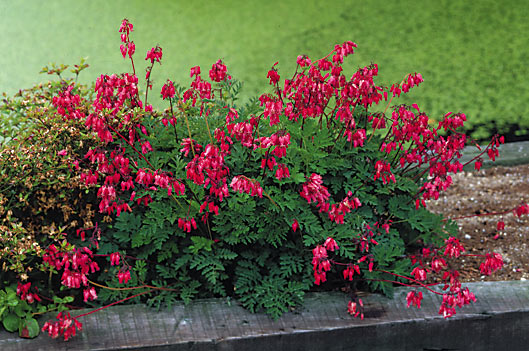 www.waysidegardens.com
www.waysidegardens.com
Dicentra ‘Luxuriant’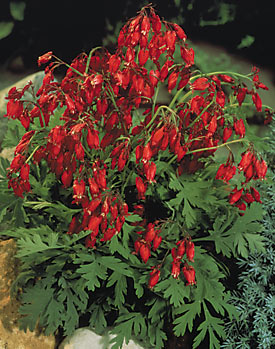 K. Van Bourgondien / 800-437-7501
K. Van Bourgondien / 800-437-7501
Dicentra ‘Bacchanal’by George Papadelis
Fern-leaf bleeding heart boasts versatility, durability, and beauty. It differs from its cousin, old-fashioned bleeding heart (Dicentra spectabilis), in many ways. Old-fashioned bleeding heart can grow up to 4 feet tall and equally wide. The common form produces the classic white “heart” shaped flowers that “bleed” rosy red “drips” on either side of each flower. The blossoms emerge in spring and gracefully cascade from arching stems. Flowers last 6 or more weeks, but the plants usually go dormant by summer. They are therefore best planted in the rear of the border behind summer bloomers. In contrast, fern-leaf bleeding heart rarely grows over 15 inches, will bloom almost all summer long without going dormant, has handsome cut-leaf foliage, and has smaller “non-bleeding” flowers. These are available in a range of leaf and flower colors that provide gardeners with many choices for their shadier spots.
Fern-leaf bleeding heart is a North American native that can actually be divided into two very similar species. The western species, Dicentra formosa (western bleeding heart), occurs naturally from northern California to British Columbia while our eastern species, Dicentra eximia (fern-leaf or fringed bleeding heart), is found from New York to Georgia. Breeders in America and Europe have used these to develop several interesting varieties with flowers that range from white to pink to lavender to deep red. ‘Luxuriant’ is the most readily available variety and has cherry red flowers above 12- to 15-inch blue-green foliage. For an excellent white, try ‘Snowdrift’ or ‘Snowflakes’; both have blue-green leaves and grow 10 to 14 inches tall. For one of the deepest reds and almost silver-blue leaves, look for ‘Bacchanal’ at only 8 to 10 inches tall. Most of the newer varieties have beautiful foliage that is worth considering for any semi-shady site.
Fern-leaf bleeding hearts form slow-spreading clumps that require no maintenance all season long. They can tolerate the coldest of winters and are not too particular about soil type as long as it isn’t too heavy. They do, however, thrive in moist, fertile soil. Plants will tolerate full sun, but prefer a semi-shaded site. Too much shade, however, will discourage flowering, which typically lasts from spring until fall. Avoid positioning this plant where competition from tree roots will occur since the lack of water and nutrients can make bleeding hearts only last for a few years. To maintain the healthiest, longest-blooming plants, divide the crown every 3 or 4 years in early spring or late summer. When planting new divisions, take advantage of this opportunity to amend your soil with organic matter such as compost, manure, or aged pine bark. Once established, this disease- and insect-resistant plant will effortlessly flower for years without requiring staking, deadheading, or pruning.
The relatively small size of fern-leaf bleeding heart makes it ideal for the front of the shady garden. It can also be used nestled between boulders in your rock garden or planted among trillium and Jack-in-the-pulpits in your woodland garden. Its tidy, bluish foliage and long season of bloom combine to make it useful as an edging plant too. The blue-green ferny leaves are contrasted beautifully by the bold purple-red leaves of coral bells (Heuchera) or by the large gold leaves of Hosta ‘Daybreak.’ Plant fern-leaf bleeding heart with an ornamental grass for shade such as golden hakone grass (Hakonechloa macra ‘Aureola’). Its fine, wispy gold leaves against the ferny blue-green leaves of the bleeding heart would provide a long-lasting combination of different colors and textures.
George Papadelis is the owner of Telly’s Greenhouse in Troy, MI.
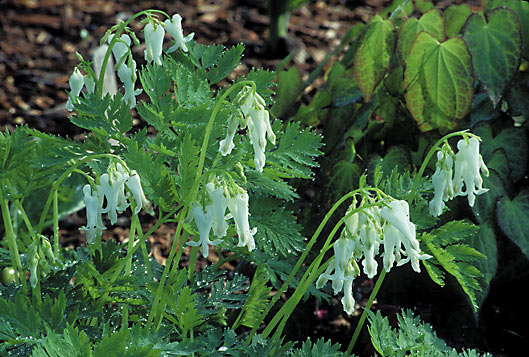 www.whiteflowerfarm.com
www.whiteflowerfarm.com
Dicentra eximia ‘Snowdrift’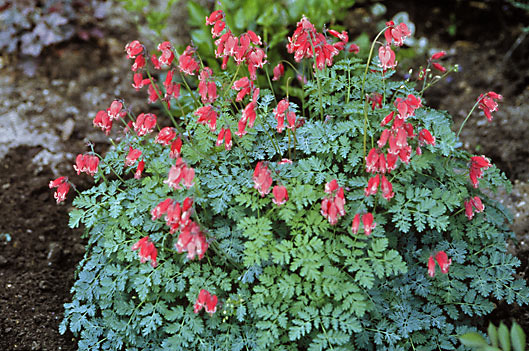 Walters Gardens
Walters Gardens
Dicentra ‘King of Hearts’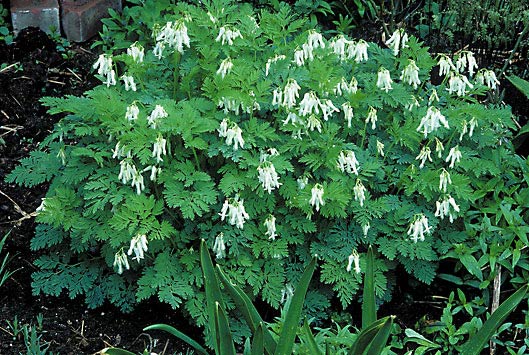 www.whiteflowerfarm.com
www.whiteflowerfarm.com
Dicentra ‘Snowdrift’
At a glance: Fern-leaf Bleeding Heart
Botanical name: Dicentra eximia (dy-SEN-truh eks-IM-ee-uh)
Plant type: Perennial
Plant size: 10 to 15 inches tall and wide
Habit: Clump-forming mound
Hardiness: Zone 3
Flower color: Pink, deep pink, cherry red, deep red, white
Flower size: 1 inch long, narrow heart-shaped
Bloom period: Spring to fall
Leaf color: Blue-green, gray-green
Leaf size: 4-12 inches long, fern-like
Light: Partial shade
Soil: Well-drained, fertile, moist
Uses: Front of the shade border; rock garden
Companion plants: Hostas (smaller, gold- and blue-leaved varieties), purple-leaved coral bells (Heucheras)
Remarks: Grown in the proper conditions, may self-seed in the garden. Divide every 3 to 4 years. Avoid dry soil areas in the summer.
